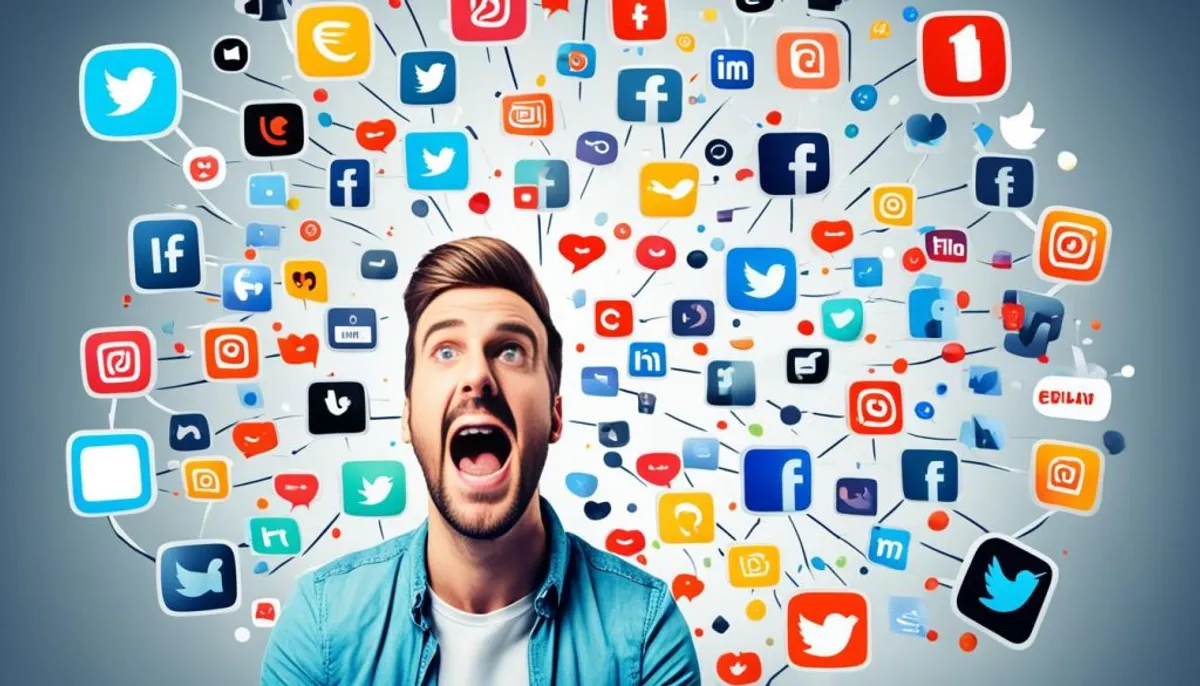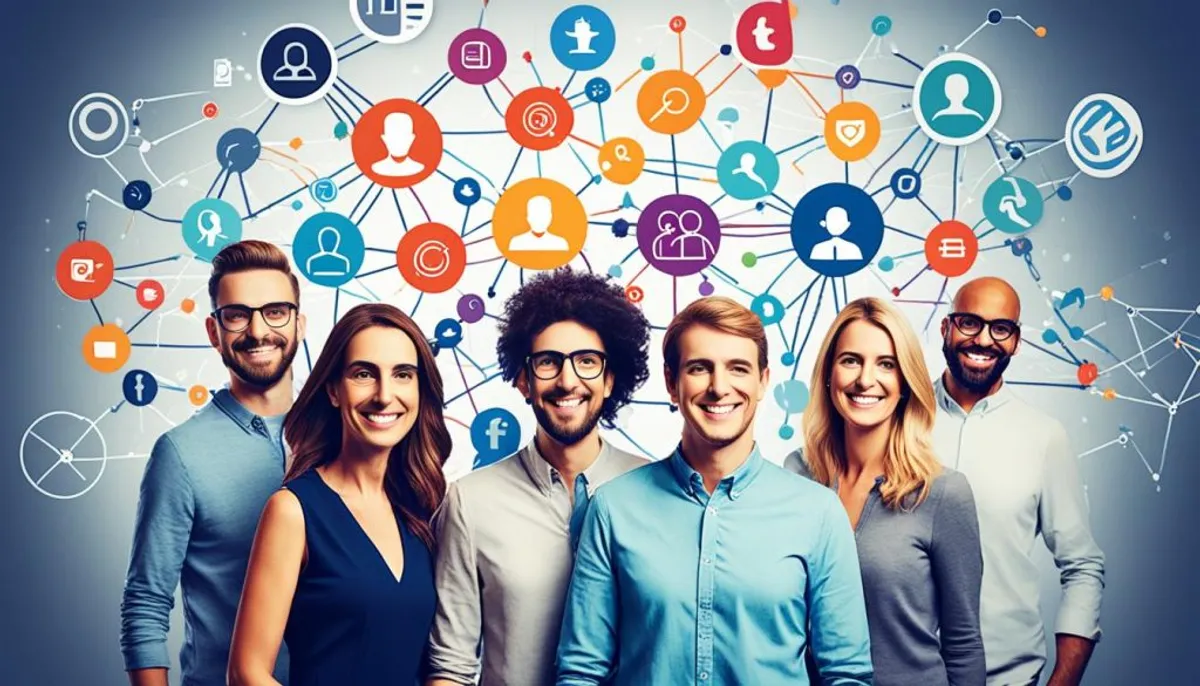In today’s fast-paced digital world, social networking is a big part of our lives. The Pew Research Center says 72% of U.S. adults use social media, even though 64% see it as mostly negative.
Social media has become like a new public square. Here, news spreads, leaders debate, and people make important connections. But, this digital craze is also linked to more anxiety, depression, and loneliness in Americans.
This article will look into the good and bad sides of social networking fever. We’ll see how our digital connections affect us in today’s world.

As we move through the changing world of online communities and virtual interactions, it’s key to grasp the complex nature of this internet trend. It deeply affects our personal and social health. By understanding the social media craze and web-based relationships, we can find a better way to use cyber socializing, online networking, and virtual engagement.
The Paradox of Social Media
Social media has changed how we connect and interact today. It has made it easier to reach out to others. But, it has also made us feel more alone in our virtual relationships.
Social media lets us connect with more people than ever before. It changes how we talk to friends, family, and even strangers. It’s been a big help during the COVID-19 pandemic, when we couldn’t meet in person.
Social Media’s Dual Nature: Connecting and Disconnecting
But, using social media too much can hurt our emotional connections. It can make us less good at talking face-to-face and make us worry about missing out, known as FOMO. Some people feel lonelier even though they’re online all the time.
The effects of social media on us are complex. It can be good and bad. We need to use it wisely to enjoy the benefits of online connections. At the same time, we should avoid the dangers of social media addiction and virtual disconnection.
The Rise of Virtual Communities
Social media has changed how we connect with others in the digital age. It has led to the growth of virtual communities and local networking platforms. These are places where people with similar interests or experiences meet, no matter where they are in the world.
Online communities are now key for support and friendship. They help those who feel alone or left out find a place to belong. Studies show they can improve mental health and lower the risk of serious mental health problems and suicide, especially for the young.
The rise of remote connections through social media has been huge for finding community. Virtual communities act as a lifeline for many. They offer a place to belong, share experiences, and build strong relationships. Utopian ideas about how technology can enhance our social interactions are becoming more relevant as we navigate these changes. As technology keeps changing, the role of online communities will only get bigger. They are a key way for people to connect and flourish in our connected world.

social networking fever: Embracing the Digital Craze
Today, social media has made people of all ages hooked. Studies show that kids and teens spend 5.5 to 8.5 hours a day on digital devices. This is especially true for Black, Hispanic/Latino, and lower-income youth. This high screen time and online activity worries parents and mental health experts. They fear it could lead to obesity, sleep problems, and delays in learning and social skills.
The rise of social media usage trends shows us how much we rely on digital platforms for digital engagement and staying connected. We use them to share photos, updates, and join online communities. Social networking has become a big part of our lives.
But, this trend has a downside. It’s making us realize we need to balance our digital lives with a healthy lifestyle. As we deal with more online activity and screen time habits, finding the right balance is key. We need to use social media’s good sides while avoiding its bad ones.
By understanding the “social networking fever,” we can create better ways to connect online. We can focus on digital wellbeing and make sure technology improves our lives, not hinders them.
The Darker Side of Social Networking
Social media has changed how we connect and talk to each other. But, it also has a darker side. Using social media too much can cause problems like sleep deprivation, obesity, behavior problems, and even internet addiction or problematic internet use. It also brings dangers like cyberbullying, sexting, and the spread of misinformation and risky behaviors.
To deal with these issues, we need a balanced approach. We should help people and families use media wisely and keep a good relationship with digital tech.
Addressing the Pitfalls of Excessive Social Media Use
The dangers of social media risks, cyberbullying, sexting, internet addiction, and problematic internet use are big and important. Experts suggest a plan to tackle these problems:
- Teach people and families about the dangers of excessive social media use, cyberbullying, and sexting. Offer help to deal with these issues.
- Help people develop good digital habits. This includes setting limits on screen time, doing things offline, and talking openly about social media use.
- Put in place strong rules and programs in schools and communities to stop and handle cyberbullying, sexting, and other online risks.
- Encourage people to be smart when using online content. They should check facts, and think about how their online actions might affect others.
By facing the darker side of social networking, we can help people and communities use digital tech wisely, especially as we navigate the evolving landscape of internet stars and trends. This way, we can enjoy its benefits while avoiding its risks and keeping a healthy balance in the digital world.

Striking a Balance in the Digital Age
Our use of digital tech and social media keeps growing. It’s key to find a balance that lets us enjoy the good parts without the bad. Making a media use plan, setting screen time limits, and having healthy media habits are key to good digital wellness today.
Strategies for Mindful Social Media Engagement
Here are some ways to balance your social media use:
- Develop a family media use plan: Talk with your family to make a plan. It should say how much screen time is okay, what digital activities are allowed, and rules for online behavior.
- Set screen time limits: Make sure everyone has limits on screen time. This ensures enough time for activities without screens and real-life chats.
- Encourage healthy media habits: Help everyone have a good relationship with tech by mixing online and offline activities. Teach critical thinking about media and show good media use yourself.
- Prioritize digital wellness: Try to take breaks and do things that make you feel good, like exercise, hobbies, and spending time with family and friends.
By being balanced and using these tips, families can enjoy social networking safely. This helps us have healthier tech habits.
Conclusion
The digital age keeps moving forward, and our love for social networking shows no signs of fading. These platforms have changed how we connect and interact with each other. But they also bring challenges that we need to face.
Virtual communities have made it easier for people to connect across distances, creating strong bonds. Yet, social media can both bring us together and tear us apart. Spending too much time online can harm our mental health and behavior.
It’s important to find a balance in our use of social media. We should enjoy its benefits while fixing its problems. By being mindful of how we use technology, we can make it a positive force in our lives. This way, we can build stronger connections in today’s digital world.
RelatedRelated articles



